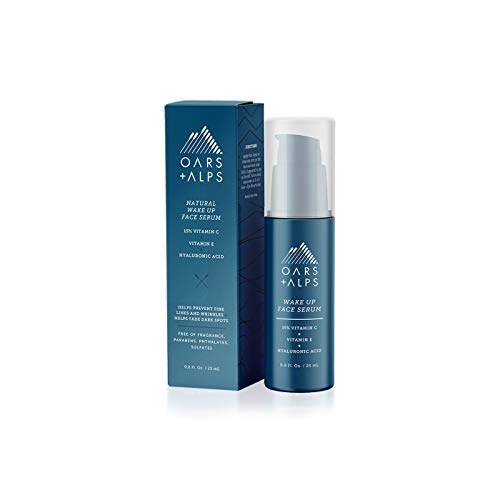
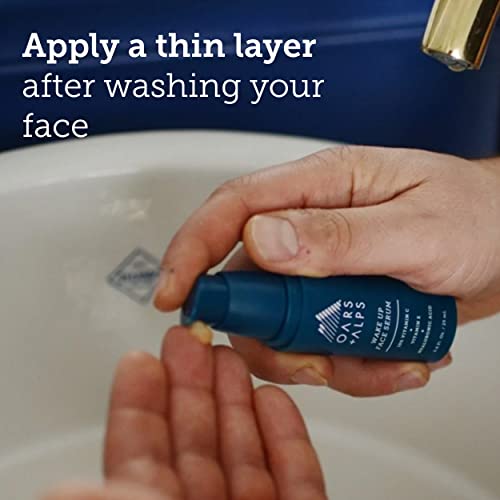
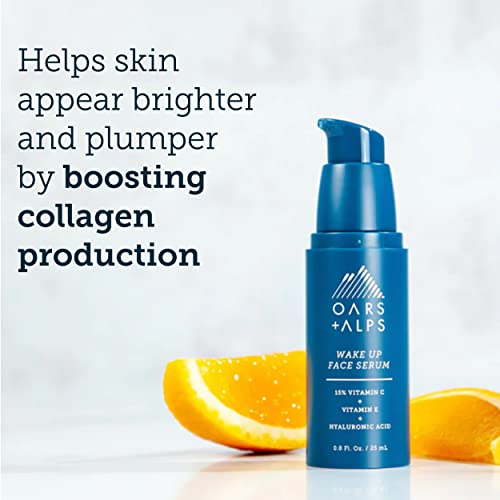
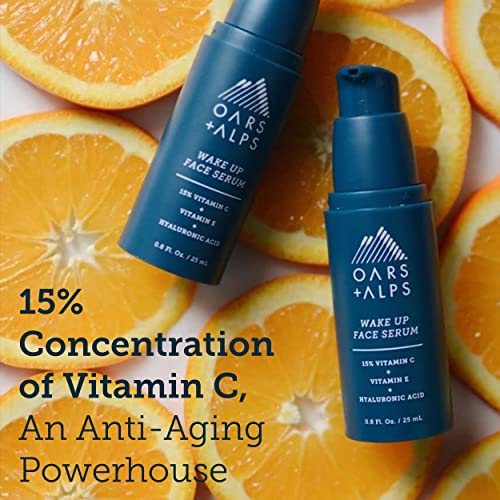
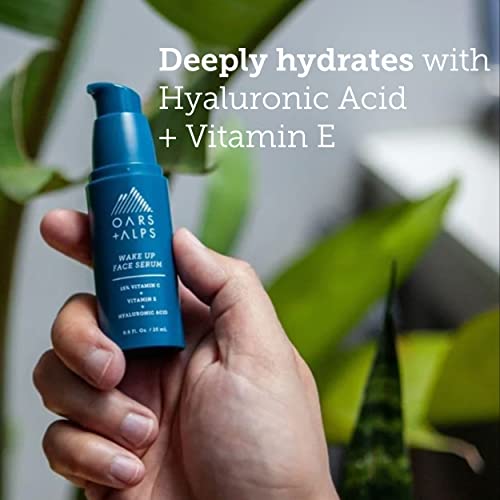
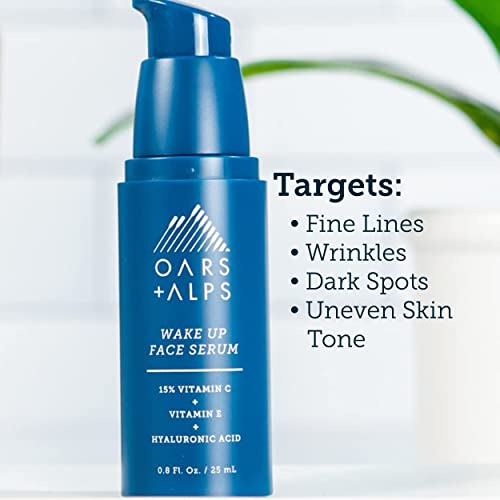
Oars + Alps Face Serum - Anti-Aging, 15% Vitamin C & Hydration, Dermatologist Tested - 0.8 Fl Oz


Algin
Medium RiskAlgin is a sodium salt of alginic acid, derived from brown seaweed. It is commonly used as a thickening agent, emulsifier, and stabilizer in various food and cosmetic products. Its ability to form gels and retain moisture makes it valuable in formulations requiring texture and consistency.
Sustai Insights
Algin provides functional benefits such as thickening and stabilizing properties in formulations and is derived from renewable marine sources, contributing to its sustainability credentials. While health risks are low regarding carcinogenicity, allergies, and reproductive toxicity, there are concerns about contamination. Environmental risks include potential pollutants and bioaccumulation. Regulatory bodies have not issued significant warnings, indicating a moderate risk level overall. Safe usage practices should be observed, and alternatives like other plant-derived thickeners may be considered for those seeking varied sourcing.
Benzoic Acid
Medium RiskBenzoic acid is a naturally occurring and synthetically produced compound commonly used as a preservative in food and cosmetic products. It helps inhibit the growth of mold, yeast, and some bacteria, thus extending shelf life and maintaining product quality.
Sustai Insights
Benzoic acid is effective as a preservative, ensuring product stability and safety. It is generally considered to have low health risks, with minimal concerns regarding carcinogenicity, allergies, or reproductive toxicity. Environmental risks are moderate, as it is not bioaccumulative but can be a pollutant. Regulatory bodies do impose certain restrictions on its use in various products. Safe usage practices should be followed to mitigate any potential risks. Available alternatives include sorbic acid and other natural preservatives, which may offer similar benefits with potentially lower environmental impact. The overall risk level is assessed as medium.
Dimethicone
Medium RiskDimethicone, also known as polymethylsiloxane, is a silicone-based polymer commonly used in personal care products for its smooth application and skin conditioning properties. It acts primarily as an emollient, providing a silky feel while forming a protective barrier on the skin.
Sustai Insights
Dimethicone provides functional benefits as an effective emollient and skin protectant, contributing to product stability and sensory attributes. It is considered low risk for carcinogenicity, allergies, and reproductive toxicity, but has moderate usage restrictions due to environmental persistence and bioaccumulation concerns. Regulatory bodies have issued advisories regarding its use in certain formulations. Overall, its risk level is assessed as medium, and users are advised to follow recommended usage practices. Alternatives like natural oils or butters may offer sustainable options.
Sorbic Acid
Medium RiskSorbic acid is a naturally occurring and synthetically produced compound primarily used as a preservative in food and cosmetic products. It effectively inhibits the growth of molds, yeasts, and some bacteria, thereby extending shelf life and maintaining product integrity.
Sustai Insights
Sorbic acid serves as an effective preservative, enhancing product longevity and safety. It is generally recognized as safe by the FDA and has a low risk for carcinogenicity, while exhibiting moderate allergenic potential. Environmental concerns include its potential as a pollutant, though it is not significantly bioaccumulative. Regulatory bodies impose few restrictions, indicating a moderate risk level overall. Safe usage practices should be followed, and alternatives like potassium sorbate may be considered for those seeking different options.
Hyaluronic Acid
Low RiskHyaluronic acid is a natural polysaccharide found in connective tissues, skin, and cartilage, primarily serving as a moisture-retaining agent in cosmetic products. Its primary function is to provide hydration and improve skin elasticity, making it a common ingredient in moisturizers and serums.
Sustai Insights
Hyaluronic acid offers significant functional benefits, such as effective hydration and skin plumping, while being biodegradable and generally recognized as safe by regulatory bodies. Health risks are minimal, with low concerns regarding carcinogenicity, allergies, or reproductive toxicity. Environmental risks are also low, as it is not considered a pollutant or bioaccumulative. Regulatory bodies have not issued major advisories against its use, resulting in an overall low-risk assessment. For safe usage, it is recommended to apply in appropriate concentrations. Alternatives include glycerin or aloe vera, which also provide hydration.
Vegetarian Glycerin
Low RiskVegetarian glycerin, also known as glycerol, is a colorless, odorless, and viscous liquid derived from plant sources. It is primarily used as a humectant, solvent, and emollient in various personal care products, helping to retain moisture and improve texture.
Sustai Insights
Vegetarian glycerin offers functional benefits as an effective humectant, promoting hydration and skin smoothness. It is biodegradable and typically sustainably sourced. Health risks associated with glycerin are low, with no significant concerns for carcinogenicity, allergens, or reproductive toxicity. Environmental risks are minimal, and it is not subject to major regulatory warnings. Overall, the risk level for this ingredient is low, making it a safe choice in formulations. Safe usage practices include ensuring proper concentrations in products, and alternatives such as propylene glycol exist but may have differing properties.
Amylopectin
Low RiskAmylopectin is a branched chain polysaccharide, primarily found in starch. It serves as a natural thickening agent and stabilizer in various cosmetic and food products, contributing to texture and consistency. Due to its structure, it is easily digestible and is a source of energy in dietary applications.
Sustai Insights
Amylopectin functions effectively as a thickener and stabilizer, enhancing product texture. It is derived from renewable sources, contributing to sustainability. Health risks are minimal, with low concerns regarding carcinogenicity, allergies, and reproductive toxicity. Environmental impacts are also low, with no significant pollutant potential. Regulatory assessments indicate no restrictions. Overall, the risk level is low, and safe usage practices should be maintained. Alternatives include other natural thickeners like guar gum or xanthan gum.
Sodium Phytate
Low RiskSodium phytate is a complex sodium salt of phytic acid, primarily used in cosmetic formulations as a chelating agent. It helps to stabilize formulations by binding metal ions, which can improve product efficacy and shelf life.
Sustai Insights
Sodium phytate offers functional benefits by enhancing product stability and is considered to have low health risks, with no significant associations with carcinogenicity, allergies, or reproductive toxicity. Environmentally, it poses minimal risks, as it is not considered a pollutant or bioaccumulative. Regulatory status indicates no significant restrictions. Overall, the ingredient is assessed as low risk. However, users should practice safe usage and consider alternatives like other chelating agents if desired.
Water
Low RiskWater is a clear, colorless liquid essential for various biological processes. It serves as a solvent in formulations, facilitating the dissolution of other ingredients and enhancing product texture and application. Additionally, water plays a crucial role in hydration and is a key component in many cosmetic and personal care products.
Sustai Insights
Water is an effective solvent and hydrator, contributing to the texture and efficacy of formulations. It is biodegradable and generally regarded as safe, with low concerns regarding carcinogenicity, allergies, and reproductive toxicity. However, excessive water usage can lead to environmental concerns, particularly regarding resource depletion. Regulatory bodies do not impose restrictions on water use in cosmetics. Overall, the risks associated with water are low, making it a safe and essential ingredient.
Xanthan Gum
Low RiskXanthan gum is a polysaccharide, a sugar-based compound produced by the fermentation of glucose or sucrose. It is commonly used as a thickening agent and stabilizer in various food and cosmetic products due to its ability to improve texture and prevent ingredient separation.
Sustai Insights
Xanthan gum serves effectively as a thickener and stabilizer, enhancing product texture and consistency. It is biodegradable and typically derived from renewable sources, supporting sustainability efforts. Health risks are minimal, with low concerns regarding carcinogenicity, allergies, and reproductive toxicity. Environmental impact is similarly low, posing no significant hazards. Regulatory agencies, including the FDA, regard it as safe for use, with no significant restrictions. Overall, xanthan gum is assessed as low risk, making it a suitable ingredient in formulations.
Lactobacillus Ferment
Low RiskLactobacillus ferment is an extract of the probiotic bacterium Lactobacillus, commonly used in cosmetic and personal care products for its potential skin health benefits. It is known for its role in fermentation processes, contributing to the formulation's efficacy as a skin conditioning agent.
Sustai Insights
Lactobacillus ferment offers functional benefits by improving skin hydration and barrier function, and it is often derived from sustainable sources. Health risks are low, with minimal concerns regarding carcinogenicity, allergies, or reproductive toxicity. Environmentally, it poses low risks, with no significant pollutant or bioaccumulation potential. Regulatory agencies do not impose restrictions on its use. Overall, the ingredient is assessed as low risk, and safe usage practices should be followed. Alternatives such as other probiotic extracts may be considered for similar benefits.
Ammonium Acryloyldimethyltaurate/Vp Copolymer
Low RiskAmmonium acryloyldimethyltaurate/VP copolymer is a synthetic polymer used primarily as a thickening and stabilizing agent in cosmetic formulations. It enhances the texture and consistency of products, allowing for improved application and feel on the skin.
Sustai Insights
This ingredient offers functional benefits as a thickener and stabilizer, contributing to product performance. It is generally recognized as having low health risks, including minimal concerns for carcinogenicity and allergies. Environmental risks are also low, with no significant pollutant or bioaccumulation potential noted. Regulatory reviews indicate no major restrictions, supporting its safe use in cosmetics. Overall, this ingredient presents a low risk profile, making it a viable option in cosmetic formulations.
Propanediol
Low RiskPropanediol is a glycol compound commonly used in cosmetic and personal care products as a solvent, humectant, and skin-conditioning agent. It serves to enhance the texture and moisture retention of formulations, contributing to overall product efficacy.
Sustai Insights
Propanediol offers functional benefits such as effective moisture retention and improved product application. It is considered low-risk in terms of health concerns, with minimal associations with carcinogenicity, allergies, or reproductive toxicity. Environmentally, it has low pollutant potential and is not bioaccumulative. Regulatory bodies have not placed restrictions on its use. Despite concerns regarding enhanced skin absorption and potential endocrine disruption, the overall assessment indicates low risk. Safe usage practices should be followed, and alternatives like glycerin or other plant-based humectants can be considered.
Ascorbic Acid (Vitamin C)
Low RiskAscorbic acid (Vitamin C) is a naturally occurring antioxidant essential for various biological functions, including collagen synthesis and immune response. It is commonly used in cosmetic and food products for its preservative properties and ability to enhance skin brightness.
Sustai Insights
Ascorbic acid provides functional benefits as an effective antioxidant and preservative, contributing to skin health and product stability. It is generally recognized as safe with low health risks, including minimal concerns for carcinogenicity and allergies. Environmentally, it poses low risks, as it is biodegradable and does not bioaccumulate. Regulatory bodies like the FDA have not imposed significant restrictions on its use. Overall, the ingredient presents a low risk, with safe usage practices ensuring consumer safety, and alternatives such as natural extracts exist for those seeking different formulations.
Ethylhexylglycerin
Low RiskEthylhexylglycerin is a glyceryl ether utilized primarily as a skin-conditioning agent and preservative in cosmetic formulations. It enhances the efficacy of preservatives and serves as a humectant, helping to retain moisture in the skin. This ingredient is commonly found in various personal care products.
Sustai Insights
Ethylhexylglycerin offers functional benefits as an effective preservative and skin-conditioning agent, contributing to product longevity and moisture retention. Health risks are generally low, with minor concerns regarding allergic contact dermatitis and irritant potential. Environmentally, it poses minimal risks, not being recognized as a pollutant or bioaccumulative. Regulatory bodies have imposed few restrictions, indicating its safety for use. Overall, its risk level is assessed as low, making it a viable option in cosmetic formulations. For those seeking alternatives, ingredients like propanediol may serve similar functions with potentially lower irritation profiles.
Beta Glucan
Low RiskBeta-glucan is a polysaccharide consisting of glucose monomers. It is commonly derived from yeast, oats, or certain fungi and is recognized for its role in skincare as a humectant and soothing agent.
Sustai Insights
Beta-glucan offers functional benefits such as skin hydration and soothing properties, suggesting potential uses in cosmetics and skincare. It is generally recognized as safe, with low concerns regarding carcinogenicity, allergies, and reproductive toxicity. Environmental risks appear minimal, with no significant pollutant or bioaccumulation potential. Regulatory bodies impose few restrictions, reflecting its low-risk profile. Safe usage practices should be followed, and while alternatives exist, beta-glucan remains a low-risk ingredient overall.
Hyaluronic Acid
Low RiskHyaluronic acid is a natural polysaccharide found in connective tissues, skin, and cartilage, primarily serving as a moisture-retaining agent in cosmetic products. Its primary function is to provide hydration and improve skin elasticity, making it a common ingredient in moisturizers and serums.
Sustai Insights
Hyaluronic acid offers significant functional benefits, such as effective hydration and skin plumping, while being biodegradable and generally recognized as safe by regulatory bodies. Health risks are minimal, with low concerns regarding carcinogenicity, allergies, or reproductive toxicity. Environmental risks are also low, as it is not considered a pollutant or bioaccumulative. Regulatory bodies have not issued major advisories against its use, resulting in an overall low-risk assessment. For safe usage, it is recommended to apply in appropriate concentrations. Alternatives include glycerin or aloe vera, which also provide hydration.
Vegetarian Glycerin
Low RiskVegetarian glycerin, also known as glycerol, is a colorless, odorless, and viscous liquid derived from plant sources. It is primarily used as a humectant, solvent, and emollient in various personal care products, helping to retain moisture and improve texture.
Sustai Insights
Vegetarian glycerin offers functional benefits as an effective humectant, promoting hydration and skin smoothness. It is biodegradable and typically sustainably sourced. Health risks associated with glycerin are low, with no significant concerns for carcinogenicity, allergens, or reproductive toxicity. Environmental risks are minimal, and it is not subject to major regulatory warnings. Overall, the risk level for this ingredient is low, making it a safe choice in formulations. Safe usage practices include ensuring proper concentrations in products, and alternatives such as propylene glycol exist but may have differing properties.
Amylopectin
Low RiskAmylopectin is a branched chain polysaccharide, primarily found in starch. It serves as a natural thickening agent and stabilizer in various cosmetic and food products, contributing to texture and consistency. Due to its structure, it is easily digestible and is a source of energy in dietary applications.
Sustai Insights
Amylopectin functions effectively as a thickener and stabilizer, enhancing product texture. It is derived from renewable sources, contributing to sustainability. Health risks are minimal, with low concerns regarding carcinogenicity, allergies, and reproductive toxicity. Environmental impacts are also low, with no significant pollutant potential. Regulatory assessments indicate no restrictions. Overall, the risk level is low, and safe usage practices should be maintained. Alternatives include other natural thickeners like guar gum or xanthan gum.
Sodium Phytate
Low RiskSodium phytate is a complex sodium salt of phytic acid, primarily used in cosmetic formulations as a chelating agent. It helps to stabilize formulations by binding metal ions, which can improve product efficacy and shelf life.
Sustai Insights
Sodium phytate offers functional benefits by enhancing product stability and is considered to have low health risks, with no significant associations with carcinogenicity, allergies, or reproductive toxicity. Environmentally, it poses minimal risks, as it is not considered a pollutant or bioaccumulative. Regulatory status indicates no significant restrictions. Overall, the ingredient is assessed as low risk. However, users should practice safe usage and consider alternatives like other chelating agents if desired.
Algin
Medium RiskAlgin is a sodium salt of alginic acid, derived from brown seaweed. It is commonly used as a thickening agent, emulsifier, and stabilizer in various food and cosmetic products. Its ability to form gels and retain moisture makes it valuable in formulations requiring texture and consistency.
Sustai Insights
Algin provides functional benefits such as thickening and stabilizing properties in formulations and is derived from renewable marine sources, contributing to its sustainability credentials. While health risks are low regarding carcinogenicity, allergies, and reproductive toxicity, there are concerns about contamination. Environmental risks include potential pollutants and bioaccumulation. Regulatory bodies have not issued significant warnings, indicating a moderate risk level overall. Safe usage practices should be observed, and alternatives like other plant-derived thickeners may be considered for those seeking varied sourcing.
Water
Low RiskWater is a clear, colorless liquid essential for various biological processes. It serves as a solvent in formulations, facilitating the dissolution of other ingredients and enhancing product texture and application. Additionally, water plays a crucial role in hydration and is a key component in many cosmetic and personal care products.
Sustai Insights
Water is an effective solvent and hydrator, contributing to the texture and efficacy of formulations. It is biodegradable and generally regarded as safe, with low concerns regarding carcinogenicity, allergies, and reproductive toxicity. However, excessive water usage can lead to environmental concerns, particularly regarding resource depletion. Regulatory bodies do not impose restrictions on water use in cosmetics. Overall, the risks associated with water are low, making it a safe and essential ingredient.
Xanthan Gum
Low RiskXanthan gum is a polysaccharide, a sugar-based compound produced by the fermentation of glucose or sucrose. It is commonly used as a thickening agent and stabilizer in various food and cosmetic products due to its ability to improve texture and prevent ingredient separation.
Sustai Insights
Xanthan gum serves effectively as a thickener and stabilizer, enhancing product texture and consistency. It is biodegradable and typically derived from renewable sources, supporting sustainability efforts. Health risks are minimal, with low concerns regarding carcinogenicity, allergies, and reproductive toxicity. Environmental impact is similarly low, posing no significant hazards. Regulatory agencies, including the FDA, regard it as safe for use, with no significant restrictions. Overall, xanthan gum is assessed as low risk, making it a suitable ingredient in formulations.
Lactobacillus Ferment
Low RiskLactobacillus ferment is an extract of the probiotic bacterium Lactobacillus, commonly used in cosmetic and personal care products for its potential skin health benefits. It is known for its role in fermentation processes, contributing to the formulation's efficacy as a skin conditioning agent.
Sustai Insights
Lactobacillus ferment offers functional benefits by improving skin hydration and barrier function, and it is often derived from sustainable sources. Health risks are low, with minimal concerns regarding carcinogenicity, allergies, or reproductive toxicity. Environmentally, it poses low risks, with no significant pollutant or bioaccumulation potential. Regulatory agencies do not impose restrictions on its use. Overall, the ingredient is assessed as low risk, and safe usage practices should be followed. Alternatives such as other probiotic extracts may be considered for similar benefits.
Ammonium Acryloyldimethyltaurate/Vp Copolymer
Low RiskAmmonium acryloyldimethyltaurate/VP copolymer is a synthetic polymer used primarily as a thickening and stabilizing agent in cosmetic formulations. It enhances the texture and consistency of products, allowing for improved application and feel on the skin.
Sustai Insights
This ingredient offers functional benefits as a thickener and stabilizer, contributing to product performance. It is generally recognized as having low health risks, including minimal concerns for carcinogenicity and allergies. Environmental risks are also low, with no significant pollutant or bioaccumulation potential noted. Regulatory reviews indicate no major restrictions, supporting its safe use in cosmetics. Overall, this ingredient presents a low risk profile, making it a viable option in cosmetic formulations.
Benzoic Acid
Medium RiskBenzoic acid is a naturally occurring and synthetically produced compound commonly used as a preservative in food and cosmetic products. It helps inhibit the growth of mold, yeast, and some bacteria, thus extending shelf life and maintaining product quality.
Sustai Insights
Benzoic acid is effective as a preservative, ensuring product stability and safety. It is generally considered to have low health risks, with minimal concerns regarding carcinogenicity, allergies, or reproductive toxicity. Environmental risks are moderate, as it is not bioaccumulative but can be a pollutant. Regulatory bodies do impose certain restrictions on its use in various products. Safe usage practices should be followed to mitigate any potential risks. Available alternatives include sorbic acid and other natural preservatives, which may offer similar benefits with potentially lower environmental impact. The overall risk level is assessed as medium.
Propanediol
Low RiskPropanediol is a glycol compound commonly used in cosmetic and personal care products as a solvent, humectant, and skin-conditioning agent. It serves to enhance the texture and moisture retention of formulations, contributing to overall product efficacy.
Sustai Insights
Propanediol offers functional benefits such as effective moisture retention and improved product application. It is considered low-risk in terms of health concerns, with minimal associations with carcinogenicity, allergies, or reproductive toxicity. Environmentally, it has low pollutant potential and is not bioaccumulative. Regulatory bodies have not placed restrictions on its use. Despite concerns regarding enhanced skin absorption and potential endocrine disruption, the overall assessment indicates low risk. Safe usage practices should be followed, and alternatives like glycerin or other plant-based humectants can be considered.
Ascorbic Acid (Vitamin C)
Low RiskAscorbic acid (Vitamin C) is a naturally occurring antioxidant essential for various biological functions, including collagen synthesis and immune response. It is commonly used in cosmetic and food products for its preservative properties and ability to enhance skin brightness.
Sustai Insights
Ascorbic acid provides functional benefits as an effective antioxidant and preservative, contributing to skin health and product stability. It is generally recognized as safe with low health risks, including minimal concerns for carcinogenicity and allergies. Environmentally, it poses low risks, as it is biodegradable and does not bioaccumulate. Regulatory bodies like the FDA have not imposed significant restrictions on its use. Overall, the ingredient presents a low risk, with safe usage practices ensuring consumer safety, and alternatives such as natural extracts exist for those seeking different formulations.
Dimethicone
Medium RiskDimethicone, also known as polymethylsiloxane, is a silicone-based polymer commonly used in personal care products for its smooth application and skin conditioning properties. It acts primarily as an emollient, providing a silky feel while forming a protective barrier on the skin.
Sustai Insights
Dimethicone provides functional benefits as an effective emollient and skin protectant, contributing to product stability and sensory attributes. It is considered low risk for carcinogenicity, allergies, and reproductive toxicity, but has moderate usage restrictions due to environmental persistence and bioaccumulation concerns. Regulatory bodies have issued advisories regarding its use in certain formulations. Overall, its risk level is assessed as medium, and users are advised to follow recommended usage practices. Alternatives like natural oils or butters may offer sustainable options.
Sorbic Acid
Medium RiskSorbic acid is a naturally occurring and synthetically produced compound primarily used as a preservative in food and cosmetic products. It effectively inhibits the growth of molds, yeasts, and some bacteria, thereby extending shelf life and maintaining product integrity.
Sustai Insights
Sorbic acid serves as an effective preservative, enhancing product longevity and safety. It is generally recognized as safe by the FDA and has a low risk for carcinogenicity, while exhibiting moderate allergenic potential. Environmental concerns include its potential as a pollutant, though it is not significantly bioaccumulative. Regulatory bodies impose few restrictions, indicating a moderate risk level overall. Safe usage practices should be followed, and alternatives like potassium sorbate may be considered for those seeking different options.
Ethylhexylglycerin
Low RiskEthylhexylglycerin is a glyceryl ether utilized primarily as a skin-conditioning agent and preservative in cosmetic formulations. It enhances the efficacy of preservatives and serves as a humectant, helping to retain moisture in the skin. This ingredient is commonly found in various personal care products.
Sustai Insights
Ethylhexylglycerin offers functional benefits as an effective preservative and skin-conditioning agent, contributing to product longevity and moisture retention. Health risks are generally low, with minor concerns regarding allergic contact dermatitis and irritant potential. Environmentally, it poses minimal risks, not being recognized as a pollutant or bioaccumulative. Regulatory bodies have imposed few restrictions, indicating its safety for use. Overall, its risk level is assessed as low, making it a viable option in cosmetic formulations. For those seeking alternatives, ingredients like propanediol may serve similar functions with potentially lower irritation profiles.
Beta Glucan
Low RiskBeta-glucan is a polysaccharide consisting of glucose monomers. It is commonly derived from yeast, oats, or certain fungi and is recognized for its role in skincare as a humectant and soothing agent.
Sustai Insights
Beta-glucan offers functional benefits such as skin hydration and soothing properties, suggesting potential uses in cosmetics and skincare. It is generally recognized as safe, with low concerns regarding carcinogenicity, allergies, and reproductive toxicity. Environmental risks appear minimal, with no significant pollutant or bioaccumulation potential. Regulatory bodies impose few restrictions, reflecting its low-risk profile. Safe usage practices should be followed, and while alternatives exist, beta-glucan remains a low-risk ingredient overall.
Experience the transformative power of Oars + Alps Anti Aging Vitamin C Serum. This potent face serum, infused with 15% Vitamin C, Hyaluronic Acid, and Vitamin E, targets fine lines, dryness, and uneven skin tone while fighting free radicals from pollution.
- Anti-Aging Benefits: Reduces redness, hyperpigmentation, and fine lines, promoting a smoother, more youthful complexion.
- Hydrating Formula: Hyaluronic Acid deeply moisturizes, helping to maintain skin elasticity and plumpness for a radiant glow.
- Clean Ingredients: Dermatologist tested and free from harmful substances, ensuring a gentle yet effective skincare solution.
- TSA-Friendly: Convenient 0.8 Fl Oz size makes it ideal for travel, fitting seamlessly into any skincare routine.
- Ethical Production: Proudly made in the USA, supporting local communities and sustainable practices, aligning with health-conscious values.
Subscribe & Save with Sustai
- Best Price Guarantee: Always enjoy the lowest prices on sustainable home essentials.
- No Surprises: We’ll notify you before shipping. No hidden fees, ever.
- You’re in Charge: Change, pause, or cancel your subscription anytime with ease.
- Eco-Friendly Deliveries: Our grouped shipments mean less packaging and lower emissions.
Join us on a sustainable journey. Special offers for a limited time! Prices and promotions may change.
Recommended Products
Experience the transformative power of Oars + Alps Anti Aging Vitamin C Serum. This potent face serum, infused with 15% Vitamin C, Hyaluronic Acid, and Vitamin E, targets fine lines, dryness, and uneven skin tone while fighting free radicals from pollution.
- Anti-Aging Benefits: Reduces redness, hyperpigmentation, and fine lines, promoting a smoother, more youthful complexion.
- Hydrating Formula: Hyaluronic Acid deeply moisturizes, helping to maintain skin elasticity and plumpness for a radiant glow.
- Clean Ingredients: Dermatologist tested and free from harmful substances, ensuring a gentle yet effective skincare solution.
- TSA-Friendly: Convenient 0.8 Fl Oz size makes it ideal for travel, fitting seamlessly into any skincare routine.
- Ethical Production: Proudly made in the USA, supporting local communities and sustainable practices, aligning with health-conscious values.

You can have at most 2 Sustainable Steals products in your cart
Customer Reviews
Customers’ View
Customers appreciate the lightweight and hydrating nature of the Oars + Alps Anti-Aging Face Serum, noting its smooth application and quick absorption without leaving a greasy residue. Many users highlight the effectiveness of the serum infused with Vitamin C, expressing satisfaction with noticeable improvements in skin softness and texture. The absence of added fragrances is praised, aligning with preferences for natural products. While some users found it less moisturizing than expected, the overall consensus is that it integrates well into skincare routines, particularly for those seeking eco-friendly options. The product's recyclable packaging further reinforces its appeal to environmentally conscious consumers. Overall, the serum is viewed positively for its quality ingredients and effectiveness in enhancing skin health.
AI-generated from the text of customer reviewsThis product has no reviews yet.




